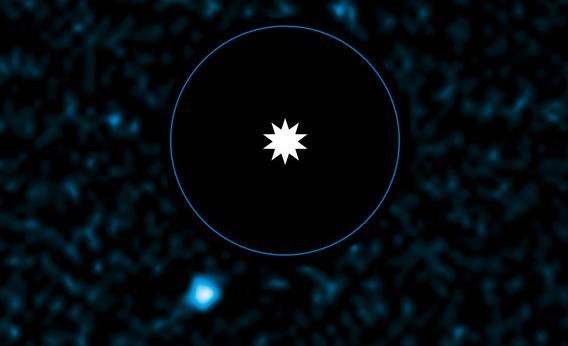Create a free profile to get unlimited access to exclusive videos, sweepstakes, and more!
Snapshot of Lowest Mass Exoplanet Ever Directly Seen (Probably)

The number of exoplanetsâworlds orbiting other starsâgrows almost daily, with about 900 such planets confirmed at this time. But the vast majority are found through indirect means: their affect on their host star, or the way their gravity distorts the light of background stars, or how much light they block when they pass between us and their star.
Only a very few have been seen directly, literally having them seen distinct from their host star in an image. Fewer than a dozen have been detected this way, and even then the existence some of those is contested (I have a gallery of all the known directly imaged exoplanets as well). But now we can (almost certainly) add another one: HD 95086 b. And a bonus: itâs the lowest mass such exoplanet seen yet.
The star, HD 95086, is very young (only about 10-17 million years old or so) and a bit more massive and hotter than the Sun. Itâs about 300 light years away, making it relatively close by on a galactic scale.
The planet is technically a candidate planet, because we canât be 100 percent sure itâs actually a planet. It could, for example, be a background star, but the astronomers who discovered it rate that possibility as very low. They observed the star three times; once in January 2012 and again in February and March of 2013. The star is close enough to Earth that its actual motion in space can be detectedâas the Sun and this star orbit the center of the galaxy, their relative positions change slightly with time. Itâs small, but measurable. The object appears to move along with the star, which it wouldnât do if it were some distant background star (like how mountains in the far distance appear to stand still but nearby trees whiz by as you drive down a road).
All in all, it looks good for this to be a bona fide planet, so from here on out Iâll call it that, but be aware, to be clear, we canât be completely sure.
Because the planet is so young, itâs still radiating away the heat leftover from its formation. Astronomers used the Very Large Telescope to observe HD 95086 b in the infrared, where itâs brightest; that makes it easier to separate out from the blinding light of its star. From its brightness and color, the astronomers estimate the planet has four to five times the mass of Jupiter, keeping it well within the mass scale of what we call a planet, and also making this the lowest mass planet ever directly seenâthe next lowest one is probably about seven times Jupiterâs mass.
HD 95086 b orbits the star at a distance of 56 times the distance of the Earth to the Sun (more than 10 times farther than Jupiter is from the Sun). Thatâs a minimum distance, assuming a circular orbit, and assuming the orbit is face-on to us. If itâs inclined, perspective shrinks the actual distance from the planet to the star, like a disk held at an angle gets thinner and looks like an ellipse.
This is not at all an Earth-like planet, Iâll note. Itâs massive, so itâs almost certainly a gas giant like Jupiter, and itâs hot, probably about 730° C (1350° F) at the tops of its clouds. Thatâs hot enough to melt tin! Itâs cool enough to have water vapor and methane in its atmosphere though. Anyway, itâs three quadrillion kilometersâ2,000,000,000,000,000 milesâaway. So donât bother packing your bags.
Still, every planet we can see directly is an important addition to our bag of knowledge. We have many different ways of detecting exoplanets, and each way helps us understand more about them. Direct imaging of an exoplanets is still a very difficult thing to do, because planets are dim, stars bright, and the separation between the two very, very small.
But weâre getting better. The technology is improving, with new and clever ideas coming along that reduce the glare and bring out the faint light of alien worlds. As time goes on, weâll find more and more of these, discovering ones ever smaller and with lower mass, and even be able to detect their atmospheric constituents. Itâs an amazing feat, and one of the triumphs of modern astronomy.














